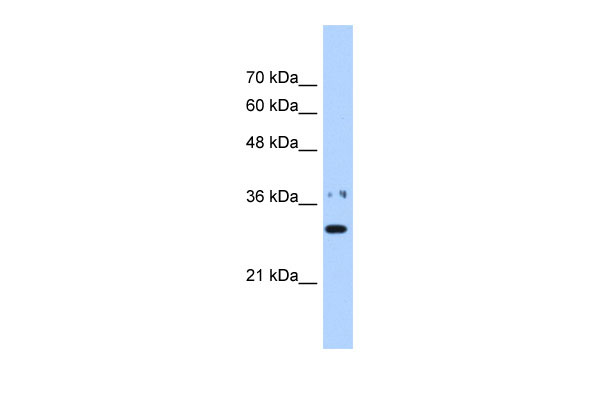NMNAT1 antibody - N-terminal region
Rabbit Polyclonal Antibody
- 产品详情
- 实验流程
Application
| WB |
|---|---|
| Primary Accession | Q9HAN9 |
| Other Accession | NM_022787, NP_073624 |
| Reactivity | Human, Mouse, Rat, Rabbit, Zebrafish, Goat, Dog, Guinea Pig, Horse, Bovine |
| Predicted | Human, Mouse, Rat, Zebrafish, Pig, Chicken, Guinea Pig, Horse |
| Host | Rabbit |
| Clonality | Polyclonal |
| Calculated MW | 31932 Da |
| Gene ID | 64802 |
|---|---|
| Alias Symbol | NMNAT, PNAT-1, PNAT1 |
| Other Names | Nicotinamide mononucleotide adenylyltransferase 1, NMN adenylyltransferase 1, 2.7.7.1, Nicotinate-nucleotide adenylyltransferase 1, NaMN adenylyltransferase 1, 2.7.7.18, NMNAT1, NMNAT |
| Format | Liquid. Purified antibody supplied in 1x PBS buffer with 0.09% (w/v) sodium azide and 2% sucrose. |
| Reconstitution & Storage | Add 100 ul of distilled water. Final anti-NMNAT1 antibody concentration is 1 mg/ml in PBS buffer with 2% sucrose. For longer periods of storage, store at 20°C. Avoid repeat freeze-thaw cycles. |
| Precautions | NMNAT1 antibody - N-terminal region is for research use only and not for use in diagnostic or therapeutic procedures. |
| Name | NMNAT1 (HGNC:17877) |
|---|---|
| Synonyms | NMNAT |
| Function | Catalyzes the formation of NAD(+) from nicotinamide mononucleotide (NMN) and ATP (PubMed:17402747). Can also use the deamidated form; nicotinic acid mononucleotide (NaMN) as substrate with the same efficiency (PubMed:17402747). Can use triazofurin monophosphate (TrMP) as substrate (PubMed:17402747). Also catalyzes the reverse reaction, i.e. the pyrophosphorolytic cleavage of NAD(+) (PubMed:17402747). For the pyrophosphorolytic activity, prefers NAD(+) and NaAD as substrates and degrades NADH, nicotinic acid adenine dinucleotide phosphate (NHD) and nicotinamide guanine dinucleotide (NGD) less effectively (PubMed:17402747). Involved in the synthesis of ATP in the nucleus, together with PARP1, PARG and NUDT5 (PubMed:27257257). Nuclear ATP generation is required for extensive chromatin remodeling events that are energy-consuming (PubMed:27257257). Also acts as a cofactor for glutamate and aspartate ADP-ribosylation by directing PARP1 catalytic activity to glutamate and aspartate residues on histones (By similarity). Fails to cleave phosphorylated dinucleotides NADP(+), NADPH and NaADP(+) (PubMed:17402747). Protects against axonal degeneration following mechanical or toxic insults (By similarity). Neural protection does not correlate with cellular NAD(+) levels but may still require enzyme activity (By similarity). |
| Cellular Location | Nucleus |
| Tissue Location | Widely expressed with highest levels in skeletal muscle, heart and kidney. Also expressed in the liver pancreas and placenta. Widely expressed throughout the brain |
Research Areas
For Research Use Only. Not For Use In Diagnostic Procedures.
Application Protocols
Provided below are standard protocols that you may find useful for product applications.
REFERENCES
Schweiger M.,et al.FEBS Lett. 492:95-100(2001).
Emanuelli M.,et al.J. Biol. Chem. 276:406-412(2001).
Fernando F.S.,et al.Gene 284:23-29(2002).
Ota T.,et al.Nat. Genet. 36:40-45(2004).
Gregory S.G.,et al.Nature 441:315-321(2006).
终于等到您。ABCEPTA(百远生物)抗体产品。
点击下方“我要评价 ”按钮提交您的反馈信息,您的反馈和评价是我们最宝贵的财富之一,
我们将在1-3个工作日内处理您的反馈信息。
如有疑问,联系:0512-88856768 tech-china@abcepta.com.























 癌症的基本特征包括细胞增殖、血管生成、迁移、凋亡逃避机制和细胞永生等。找到癌症发生过程中这些通路的关键标记物和对应的抗体用于检测至关重要。
癌症的基本特征包括细胞增殖、血管生成、迁移、凋亡逃避机制和细胞永生等。找到癌症发生过程中这些通路的关键标记物和对应的抗体用于检测至关重要。 为您推荐一个泛素化位点预测神器——泛素化分析工具,可以为您的蛋白的泛素化位点作出预测和评分。
为您推荐一个泛素化位点预测神器——泛素化分析工具,可以为您的蛋白的泛素化位点作出预测和评分。 细胞自噬受体图形绘图工具为你的蛋白的细胞受体结合位点作出预测和评分,识别结合到自噬通路中的蛋白是非常重要的,便于让我们理解自噬在正常生理、病理过程中的作用,如发育、细胞分化、神经退化性疾病、压力条件下、感染和癌症。
细胞自噬受体图形绘图工具为你的蛋白的细胞受体结合位点作出预测和评分,识别结合到自噬通路中的蛋白是非常重要的,便于让我们理解自噬在正常生理、病理过程中的作用,如发育、细胞分化、神经退化性疾病、压力条件下、感染和癌症。






